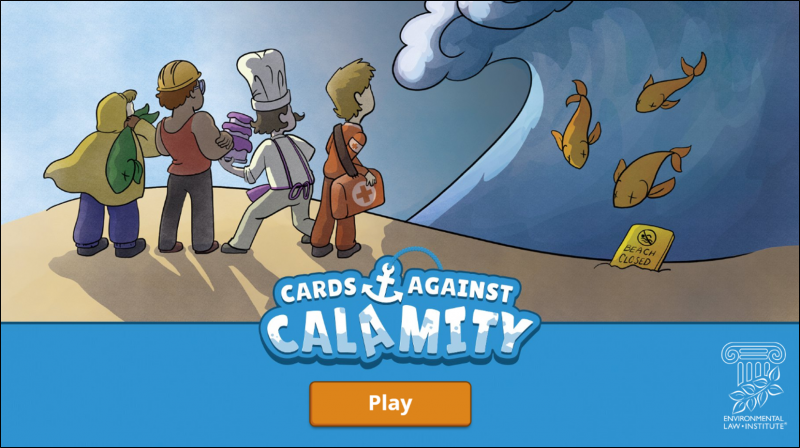What would you do if your job was to manage a small coastal community besieged by job loss, irate voters, hurricanes, oil spills, and hipsters? Here’s a way to find out: boot up your laptop or tablet and check out ELI’s new “serious game,” Digital Cards Against Calamity.
In the wake of Hurricanes Maria, Irma, Harvey, and Florence, which have resulted in an estimated total of over 3,200 deaths and more than $375 billion in damage, finding ways to increase a community’s “resilience IQ” should be a national priority. Knowing that a game has the potential to reach much broader audiences than does an academic journal article or policy brief (and can also provide important data to policymakers on public awareness and decisionmaking), in 2017 the Environmental Law Institute and 1st Playable Productions launched Cards Against Calamity, a so-called serious game designed to be not only entertaining, but also educational. This month, ELI and 1st Playable Productions have taken Cards Against Calamity online by converting the award-winning board game into a digital format. In this new game, the player takes on the role of mayor and must keep the town running while managing both shocks, such as earthquakes and hurricanes, and stresses, such as aging infrastructure and water pollution. While the web-based version is single-player—as opposed to the board game, in which 2-4 people had to work as a team—the player still must balance the needs of different stakeholder groups if they are to succeed. Players can currently simulate running towns in New England or on the Pacific Coast, with more regions coming soon.
What’s This About Resilience?
 About now, you may be wondering, “what is it that players are actually learning about?” The answer is “community resilience,” which has come into the spotlight in recent years as a paradigm for disaster preparation and response. Businesses, nongovernmental organizations, and federal, state, and local government agencies of all scopes and scales have incorporated resilience into their own operations or developed guides to help other organizations do so. Different focuses of resilience have similarly proliferated. Among the many new approaches, coastal, urban, and climate resilience have sought to apply the tenets of community resilience to different contexts. (This is but a small sampling of the range of resilience options: pick any similar field, plug it into Google followed by “resilience,” hit enter, and you’ll be met with no shortage of links.)
About now, you may be wondering, “what is it that players are actually learning about?” The answer is “community resilience,” which has come into the spotlight in recent years as a paradigm for disaster preparation and response. Businesses, nongovernmental organizations, and federal, state, and local government agencies of all scopes and scales have incorporated resilience into their own operations or developed guides to help other organizations do so. Different focuses of resilience have similarly proliferated. Among the many new approaches, coastal, urban, and climate resilience have sought to apply the tenets of community resilience to different contexts. (This is but a small sampling of the range of resilience options: pick any similar field, plug it into Google followed by “resilience,” hit enter, and you’ll be met with no shortage of links.)
Despite (or perhaps because of) this recent increase of interest in resilience, little consensus exists as to what resilience actually means. A literature review published in February of 2017 reviewed 80 relevant papers and identified as many as 72 unique definitions of community resilience, noting that “there was no evidence of a common, agreed definition of community resilience.” Moreover, this figure is taken solely from the academic literature and says nothing of the range of understanding likely held by the general populace; it is also certain to have grown in the 18 months since it was published.
This lack of conceptual clarity is especially relevant now after a spate of natural disasters has evinced the insufficiency of many communities’ resilience. (Consider not just the aforementioned hurricanes, but events such as wildfires and terrorist attacks.) Greater community resilience—in the sense of the ability of the community to help those who need it most, such as people who cannot afford to evacuate or are otherwise unable to prepare adequately for an impending disaster—is clearly necessary. And, I submit, an improved awareness and understanding of community resilience is crucial to actually improving community resilience. While plenty of ink has been spilled on the topic, it is evident that people either are not reading or are not acting upon the profusion of resilience research. Cards Against Calamity is an attempt to bridge the gap between resilience theory and practice by putting knowledge into the hands of the general public.
The goal, of course, is not to turn players into resilience experts capable of singlehandedly protecting their communities from disaster overnight. Rather, the hope is that they will come away from the game with a greater understanding of the role resilience can play in helping a community withstand disaster. Moreover, it aims to reflect the importance of balance and compromise in resilience, as well as promote a greater interest in resilience overall (It doesn’t hurt that they can provide valuable insights into their thought process and approach to the game while playing). While playtesting has indicated that players leave the game with these takeaways, don’t take our word for it: play the game yourself.
